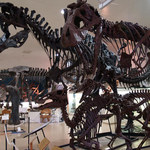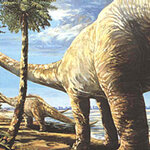Paleontology

Chuckanut Drive, in northwestern Washington provides a visual feast from sea to sky. An amazing array of plants and animals call this coastline home.
For the fossil enthusiast, it is a chance to slip back in time and have a bird’s eye view to a more tropical time. Snug up against the Pacific Ocean, this 6000 m thick exposure yields a vast number of tropical and flowering plants that you might see in Mexico today. Easily accessible by car, this rich natural playground makes for an enjoyable daytrip just one hour south of the Canada/US Border.
Over vast expanses of time, powerful…

A team of biomechanical and paleontological researchers at University of Manchester are exploring a question that teenaged dinosaur girls have wondered for years: how thin should a dinosaur model be?
Karl Bates and his team built their supermodels using a framework reconstructed from museum-installed skeletons, using an infrared laser scanning technique called LiDAR.
Dinosaur modeling is as old as humankind’s fascination with fossils. Full-scale modeling offers researchers more than a heck of a conversation piece—a life-sized, life-weighted dinosaur replica gives paleontologists a tangible…

Looking for a great family vacation this summer? If you happen to be in BC's glorious interior, stop by and visit Cache Creek, the gateway to B.C.'s Cariboo Country. They boast cowboys aplenty, horses and, as it happens, some great fossil localities.
Some of the finest fossil fish, insects and plants remains can be found at McAbee, near Cache Creek. While the site is now an arid hillside topped with finger-like hoodoos, some 51 million years ago it was a flourishing lake. As fish and other inhabitants died, their remains settled to the bottom and were preserved in the fine-grained…

The Paleontologist community in China and around the world are all aflutter over a recent find in the Erlian Basin of Inner Mongolia. Known more for its heavy oil potential and favorite export - pollution, northeastern China is the preferred stomping ground for the savvy petroleum geologist.
As a complete aside, northern China also boasts the prettiest portion of the gene pool, or so says one of my stomping friends having explored much of Asia. So, home to pretty women today and, as it would seem, an enormous bird-like dinosaur some 70 million years ago.
Fancy that.
Only a youngster…

The big five extinctions are regularly the subject of many investigations, and speculations regarding the causes, the main culprits being often put down to asteroid, or other extra terrestial impacts. Ongoing investigations by paleontologists, together with satellite surveillance, continues to reveal, more and massive impacts , some leaving evidence of 1000 mile diameter crater rims. And this precludes …

Triceratops had three horns but it was not just to impress the females, says a research study led by Andrew Farke, curator at the Raymond M. Alf Museum of Paleontology, located on the campus of The Webb Schools. They used them to settle disputes as wel. Battle scars on the skulls of Triceratops preserve rare evidence of Cretaceous-era combat, they say.
If Triceratops fought each other with their horns, wounds from this combat would be preserved in the fossil bones so Farke joined forces with paleontologists Ewan Wolff of the School of Veterinary Medicine at the University…

The official State Dinosaur of Texas is up for a new name, based on Southern Methodist University research that proved the titleholder has been misidentified. State Rep. Charles Geren of Fort Worth filed a resolution Jan. 7 to change the name of the state dinosaur from Pleurocoelus to Paluxysaurus jonesi to correctly name the massive sauropod whose tracks and bones litter the central Texas Jones Ranch. Peter Rose is the scientist behind the name change: His master's level study of dinosaur bones at SMU eventually led him to dispute the long-accepted notion that the large, sauropod bones…

A solution to the puzzle which came to be known as ‘Darwin’s Dilemma’ has been uncovered by scientists at the University of Oxford in a paper published in the Journal of the Geological Society.
‘To the question of why we do not find rich fossiliferous deposits belonging to these…periods prior to the Cambrian system, I can give no satisfactory answer’, Charles Darwin wrote in On the Origin of Species by Means of Natural Selection, or The Preservation of Favoured Races in the Struggle for Life in 1859, summarizing what came to be known as ‘Darwin’s Dilemma’ – the lack of fossils in…

New research in Science suggests that some meat-eating dinosaurs were super dads - three types of dinosaurs were sole care givers for their mate's eggs. They also may have had multiple mates and watched all their eggs at once.
The dinosaurs in the study were close ancestors of birds, and their fossils were found on top of unusually large clutches, said David Varricchio, a Montana State Universitypaleontologist and lead author of the paper. It's possible, he said, that the males mated with several females who laid their eggs in one large clutch. When the females left, the males…

400 million years ago when early arthropods would have established the three pairs of legs while evolving from having had more. Recently,80 million years ago diverse insects evolved and began to take flight. It seems this occurred long before the birds, bats, and even the pterosaurs. The wings of these hexapods were initially flat board-like appendages, and they were just for helping these critters practically hop from place to place, but with a little more loft supplied by these simple wings that only flapped straight up and down, As the insects evolved further, and increased in numbers and…